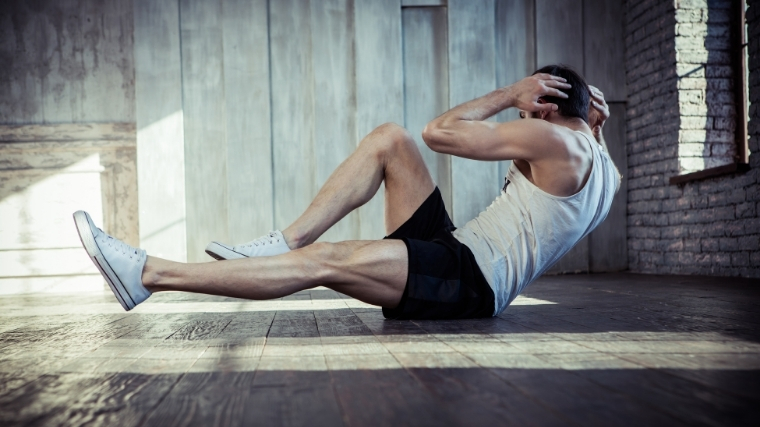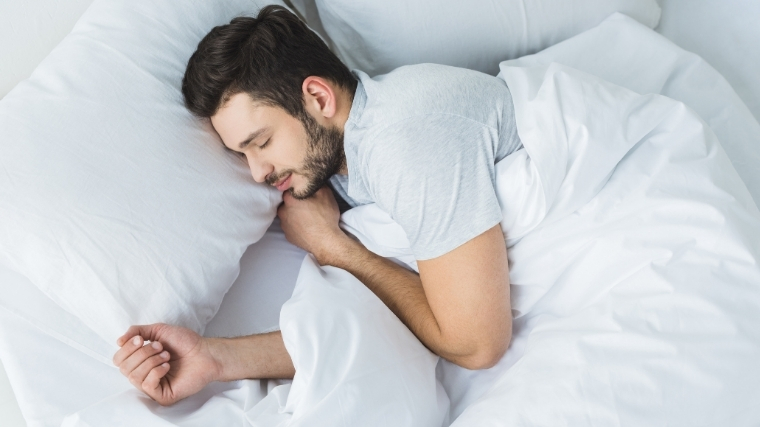If you’ve ever started a new workout program or spent a few hours shoveling your car out of the snow, you know what it’s like to have sore muscles. And you’ve probably spent some time trying to find the best way to get on the road to recovery.
Muscle recovery has become a lucrative business on its own. From cryotherapy to massage guns, people are trying to profit from you finding a way to feeling human again. And countless supplements and “health drinks” tout increased muscle recovery benefits. Is there any truth to them?
In this piece, we’ll go over the process of muscle recovery, what you can do to speed up the process, and how you should eat to enhance your recovery. (Be sure to read everything over before your next leg day.)
Editor’s note: The content on BarBend is meant to be informative in nature, but it shouldn’t take the place of advice and/or supervision from a medical professional. The opinions and articles on this site are not intended for use as diagnosis, prevention, and/or treatment of health problems. Speak with your physician if you have any concerns.
What Causes Sore Muscles?
Before we go over how muscle recovery works, you need a quick crash course on why it’s even necessary. And that involves talking about muscle soreness.
In short, muscle soreness is a consequence of any strenuous physical activity, especially if you’re a first-time trainee or starting a new program.

When you work out, the goal is to make your muscles bigger (this is called hypertrophy). To accomplish this, you resistance train to create microscopic tears in the muscle tissue. The muscle then repairs those tears, and in the process, makes itself bigger (which is its way of combating further stress).
Those tears, coupled with inflammation caused by stress on the muscle, create the sensation of muscle soreness. If you’re new to the world of working out, expect the soreness to hit you anywhere from 24-48 hours after a training session. The pains should be minor, but keep in mind the harder your training session, the more severe your soreness will be. (Of course, you should consult a doctor about any serious, long-lasting pain.)
It’s Not a Lactic Acid Trip
A popular gym bro theory is that muscle soreness is attributed to a buildup of lactic acid (a chemical byproduct created by cells while you’re body is under stress) in the muscles.
The idea behind this train of thought is that lactic acid raises your blood’s acidity, which creates soreness. So, to recover from training sessions, it’s thought that the key is to remove the lactic acid from your system. This can be done by eating or drinking certain foods, cranberry juice being 2017 World’s Strongest Man Eddie Hall’s vice of choice, or even certain massage techniques.
The problem is that lactic acid has nothing to do with muscle soreness. This has been known since 1937, when a study found that lactic acid leaves your system quite quickly after a training session. About half of the lactic acid leaves your system 15 minutes after exercise, according to the study. (1)
Those findings have been replicated numerous times in the following decades. One such study tracked lactic acid levels while runners were on a treadmill and found the subjects’ levels were the highest while on an even slope, but there was no significant muscle soreness following that session. (2)
Another fact that disproves the lactic acid theory is that, after some time, your body gets accustomed to your workouts. Sessions that once had you on the couch for the weekend now seem like a breeze to you. Yet your body is still generating lactic acid — so, by that logic, you should still be in pain.
Lactic acid buildup can result in more serious conditions, including heart problems, but muscle soreness isn’t one of them.
How Your Muscles Recover From a Workout
We touched on this above, but to reiterate: muscles repair the broken down strands during training, resulting in larger muscle tissue and larger muscles. Here, we’ll go a little more in-depth on how that actually happens.
Those microscopic tears aren’t the only things that change during a workout — your hormone levels fluctuate, your body uses up its fuel sources (the food you eat), it loses electrolytes through sweat, and so on.

Think about your body like a laptop for a moment. Your central nervous system, endocrine system, skeletal muscle system, and other systems are like the protective software you install on it (anti-virus, anti-malware, etc.).
Whenever your body undergoes any stress — whether from a cold or a strenuous workout — those systems go into overdrive trying to assess the problem, remove anything that doesn’t belong there, and bring the body back to normal (or homeostasis), just as the software would if it detects a virus.
Your endocrine system is delivering human growth hormones and testosterone to the muscles to strengthen them. Your CNS is creating synapses to respond to the stimuli you placed on it. Your skeletal system is regenerating itself if necessary to avoid further, more serious injury.
Back to the computer example: There are times when your computer might need to be restarted for the software to do its job properly. The same goes for your body, and in the following sections, we’ll go over what you need to do to ensure everything is working as it should.
How long until your muscles are recovered?
If you’re one of those people already in pain and wondering when it’s going to end, we have some bad news — we don’t know the answer to that. A light workout might take only 24 hours to recover from with minimal soreness, but a more challenging session could result in three days’ worth of recovery.
The American Council on Exercise generally recommends giving muscles 48 hours to recover from a training session. This is why most workout splits separate each muscle group by two days.
If your soreness persists for five or more days, you should consult an expert to ensure you haven’t caused any injury to the muscle tissue or bones.
Sleep Your Way to Recovery
If you’ve ever pulled an all-nighter in college, you know how sluggish you feel the day after.
This isn’t good under any circumstance, but especially when your body is busy trying to help your muscles recover. One 2020 study found sleep deprivation impacted your body’s response to inflammation, i.e., the thing we want to get rid of to stop being sore. (3)

Sleep deprivation’s impact on inflammation was also a central point of a 2011 study that found that those who didn’t get enough Zs at night had less cortisol — the hormone that treats inflammation. The same study also found decreased levels of protein synthesis (more on that in a bit) and that subjects even lost lean muscle mass. (4)
Our bodies don’t stop working during sleep, but they’re working less hard than when we’re awake. This period allows for the aforementioned skeletal, endocrine, and other systems to function as they should without any interruption. Yes, the recovery process starts before you hit the sack, but it speeds up once you finally drift off into dreamland.
Generally, you want to aim for seven to nine hours of sleep each night. That number might be on the higher side if you just ran a marathon compared to someone who just did some light yoga.
What to Eat for Muscle Recovery
If sleep is like restarting your computer, eating is like installing the latest upgrade. This is because your muscles, and many other parts of your body, are made up of proteins. Therefore, it needs new proteins to rebuild the damaged muscles.
Whether it be a chicken breast or a scoop of whey protein, the protein you eat is absorbed by the body through a process called protein synthesis. This is simply a fancy way of saying that your body is taking the protein molecules and absorbing them for future use (such as rebuilding muscle).
While most of your protein should come from your daily food intake, there’s ample evidence that protein supplements — such as protein powder — can aid in further reducing muscle soreness, but only if taken after training sessions. (5)
The same effect was found with branch chain amino acid supplements — amino acids are the strands that makeup protein molecules. Researchers found these supplements reduce skeletal muscle breakdown, thereby reducing the effects of muscle soreness. Specifically, you want to find a supplement high in the amino acid leucine, which controls muscle contraction. Aim for 20 milligrams of leucine per kilogram of bodyweight. (6)
How much protein you need to eat is dependent on the intensity of your workouts and your size. Typically you want to aim for anywhere from one and a half to three grams of protein per kilogram of body weight, but this is something your personal trainer or nutritionist can determine for you.
We won’t go too in-depth on carbs and fats — while they’re vital to fat loss and muscle gain, their roles in muscle recovery isn’t as vital as protein. Just ensure you’re getting enough calories from all three macronutrients to reach whatever goal you’re chasing.
Anti-inflammatory Foods
As we pointed out, part of muscle soreness is caused by inflammation. Certain foods can either reduce or increase inflammation in the body. To that end, stay away from any processed foods such as fried foods or pastries. Red meat has also been found to be an inflammatory food.
Some anti-inflammatory foods include fish, leafy vegetables, olive oil, and fruits. Coffee is also another anti-inflammatory beverage.
What’s the Best Muscle Recovery Method?
We’ve already established that muscle recovery is, for the most part — a physiological process that takes time. That doesn’t mean you’re entirely helpless, though, and there are some things you can do to help your body out. In this section, we’ll go over some of those methods.

Stretching the Truth on Muscle Recovery
You’ve probably been told to stretch before and after a workout, and someone may have even told you this will prevent any soreness. Stretching is important before any workout, and it’s been proven to help prevent injuries in trainees.
The science on whether it will prevent any soreness is a little less clear. Most studies on the matter say there is some difference in soreness levels between those who stretch before and after exercise, but it’s minimal in most cases (7).
Stretching might help you perform better, which could result in less strain on the body. But don’t expect a downward dog to take away any stiffness in your muscles the day after a workout.
Hold the RICE
Even if you’re not familiar with the acronym, you’ve undoubtedly heard of the concept of RICE: Rest, Ice, Compress, and Elevate. This is the normal go-to strategy for any muscle strain.
Just like the lactic acid theory, this is another disproven method. A 2012 study found it was not a proven method for treating ankle sprains and that such injuries need to be evaluated by an expert to ensure no further injuries occur. (8)
The reason for this has to do with the “Ice” portion of RICE — the cold from the ice causes your blood vessels to narrow. Why is this bad? As we said, your body knows what to do when it’s injured or under stress. It sends cells and hormones to take care of the issue.
But if your blood vessels are narrowed, it’s going to take longer for those cells to arrive. Think of the vessels as a highway and the cells as cars — narrowing the highway will cause a traffic jam. You want the cells to arrive as quickly as possible. Otherwise, it may take longer for the injury to heal.
Get a Massage
It turns out that one of the best methods for muscle recovery is a good old-fashioned massage. A huge study published in Frontiers in Physiology examined numerous studies on muscle recovery and looked at active recovery, compression garments, cryotherapy, and other popular methods.

The result? Massages resulted in the most drastic decrease in muscle soreness and fatigue. The researchers found that massaging the muscles for 20 minutes resulted in improved blood markers and hormone levels. (9)
This doesn’t mean you have to find a professional masseuse — multiple studies have found that massage guns, such as TheraGun or Hyperice, are just as effective at preventing muscle soreness as a traditional massage (10).
More Recovery Tips
Make sure your recovery game is on point. Check out these other BarBend articles to optimize muscle recovery and boost performance in the gym.
- 7 Strategies to Improve Recovery and Adapt From Hard Training
- 6 Ways to Improve Your Recovery When You’re Stressed Out
- How to Structure Active Recovery Days
References
- Newman, E. V., Dill, D. B., Edwards, H. T., & Webster, F. A. (1937). THE RATE OF LACTIC ACID REMOVAL IN EXERCISE. American Journal of Physiology-Legacy Content, 118(3), 457–462. https://doi.org/10.1152/ajplegacy.1937.118.3.457
- James A. Schwane, Bruce G. Watrous, Scarlet R. Johnson & Robert B. Armstrong (1983) Is Lactic Acid Related to Delayed-Onset Muscle Soreness?, The Physician and Sportsmedicine, 11:3, 124-131, DOI: 10.1080/00913847.1983.11708485
- Dáttilo M, Antunes HKM, Galbes NMN, Mônico-Neto M, DE Sá Souza H, Dos Santos Quaresma MVL, Lee KS, Ugrinowitsch C, Tufik S, DE Mello MT. Effects of Sleep Deprivation on Acute Skeletal Muscle Recovery after Exercise. Med Sci Sports Exerc. 2020 Feb;52(2):507-514. doi: 10.1249/MSS.0000000000002137. PMID: 31469710.
- Dattilo, M., Antunes, H. K. M., Medeiros, A., Mônico Neto, M., Souza, H. S., Tufik, S., & de Mello, M. T. (2011). Sleep and muscle recovery: Endocrinological and molecular basis for a new and promising hypothesis. Medical Hypotheses, 77(2), 220–222. https://doi.org/10.1016/j.mehy.2011.04.017
- Pasiakos SM, Lieberman HR, McLellan TM. Effects of protein supplements on muscle damage, soreness and recovery of muscle function and physical performance: a systematic review. Sports Med. 2014 May;44(5):655-70. doi: 10.1007/s40279-013-0137-7. PMID: 24435468.
- Sharp, Carwyn P M1; Pearson, David R2 Amino Acid Supplements and Recovery from High-Intensity Resistance Training, Journal of Strength and Conditioning Research: April 2010 – Volume 24 – Issue 4 – p 1125-1130 doi: 10.1519/JSC.0b013e3181c7c655
- Witvrouw E, Mahieu N, Danneels L, McNair P. Stretching and injury prevention: an obscure relationship. Sports Med. 2004;34(7):443-9. doi: 10.2165/00007256-200434070-00003. PMID: 15233597.
- van den Bekerom, M. P. J., Struijs, P. A. A., Blankevoort, L., Welling, L., van Dijk, C. N., & Kerkhoffs, G. M. M. J. (2012). What Is the Evidence for Rest, Ice, Compression, and Elevation Therapy in the Treatment of Ankle Sprains in Adults? Journal of Athletic Training, 47(4), 435–443. https://doi.org/10.4085/1062-6050-47.4.14
- Dupuy O, Douzi W, Theurot D, Bosquet L and Dugué B (2018) An Evidence-Based Approach for Choosing Post-exercise Recovery Techniques to Reduce Markers of Muscle Damage, Soreness, Fatigue,and Inflammation: A Systematic Review With Meta-Analysis. Front. Physiol. 9:403. doi: 10.3389/fphys.2018.00403
- Imtiyaz, S., Veqar, Z., & Shareef, M. Y. (2014). To Compare the Effect of Vibration Therapy and Massage in Prevention of Delayed Onset Muscle Soreness (DOMS). JOURNAL OF CLINICAL AND DIAGNOSTIC RESEARCH. https://doi.org/10.7860/jcdr/2014/7294.3971
Featured image: fotoliza/Shutterstock